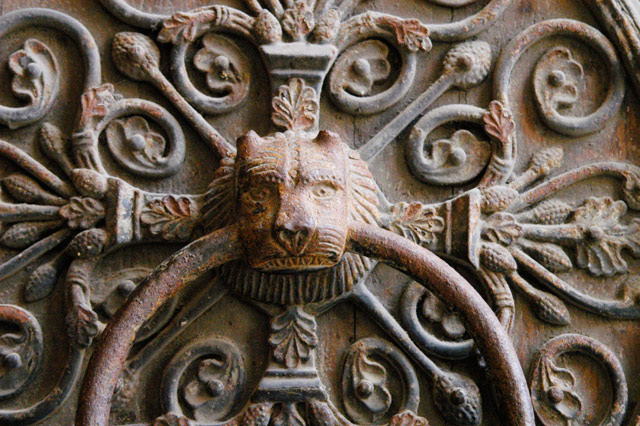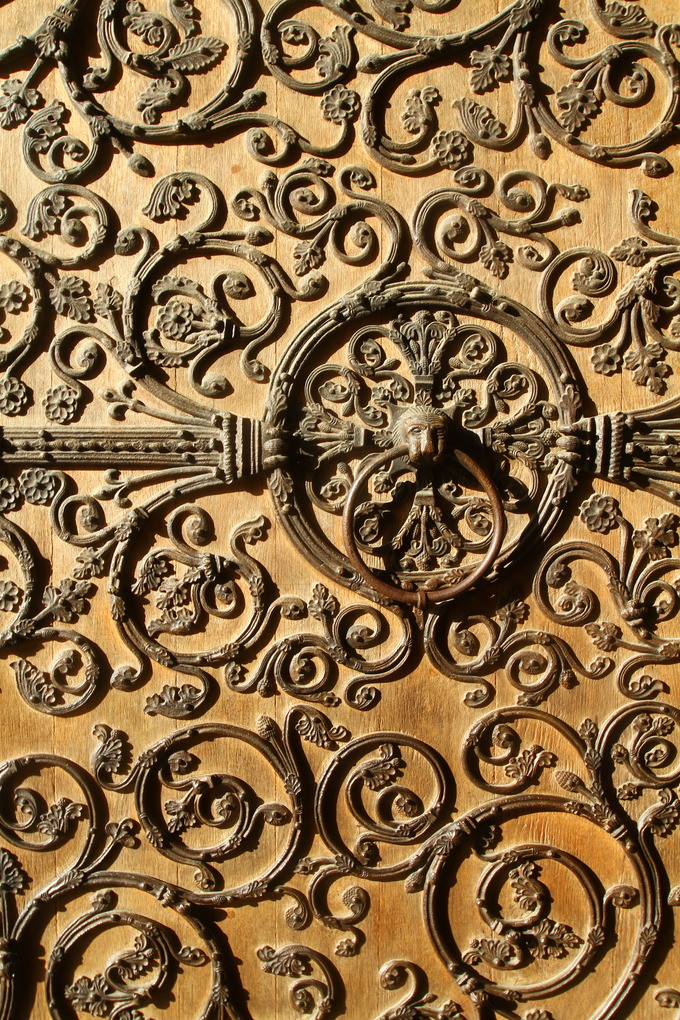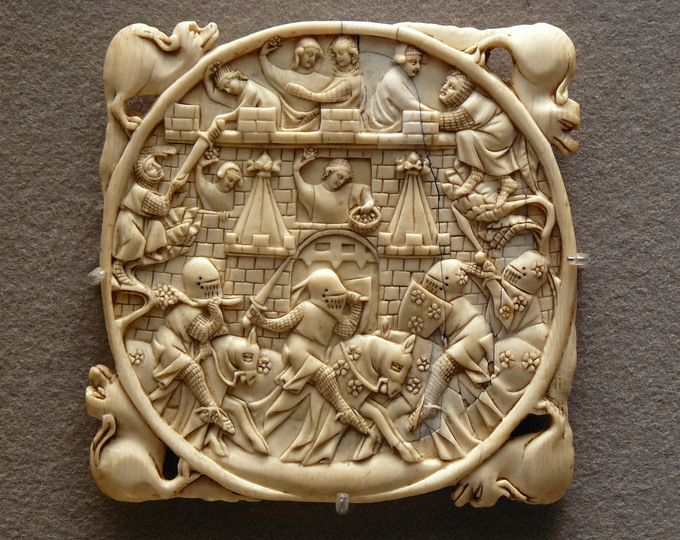18.5: Gothic Metalwork
- Page ID
- 53055
\( \newcommand{\vecs}[1]{\overset { \scriptstyle \rightharpoonup} {\mathbf{#1}} } \)
\( \newcommand{\vecd}[1]{\overset{-\!-\!\rightharpoonup}{\vphantom{a}\smash {#1}}} \)
\( \newcommand{\dsum}{\displaystyle\sum\limits} \)
\( \newcommand{\dint}{\displaystyle\int\limits} \)
\( \newcommand{\dlim}{\displaystyle\lim\limits} \)
\( \newcommand{\id}{\mathrm{id}}\) \( \newcommand{\Span}{\mathrm{span}}\)
( \newcommand{\kernel}{\mathrm{null}\,}\) \( \newcommand{\range}{\mathrm{range}\,}\)
\( \newcommand{\RealPart}{\mathrm{Re}}\) \( \newcommand{\ImaginaryPart}{\mathrm{Im}}\)
\( \newcommand{\Argument}{\mathrm{Arg}}\) \( \newcommand{\norm}[1]{\| #1 \|}\)
\( \newcommand{\inner}[2]{\langle #1, #2 \rangle}\)
\( \newcommand{\Span}{\mathrm{span}}\)
\( \newcommand{\id}{\mathrm{id}}\)
\( \newcommand{\Span}{\mathrm{span}}\)
\( \newcommand{\kernel}{\mathrm{null}\,}\)
\( \newcommand{\range}{\mathrm{range}\,}\)
\( \newcommand{\RealPart}{\mathrm{Re}}\)
\( \newcommand{\ImaginaryPart}{\mathrm{Im}}\)
\( \newcommand{\Argument}{\mathrm{Arg}}\)
\( \newcommand{\norm}[1]{\| #1 \|}\)
\( \newcommand{\inner}[2]{\langle #1, #2 \rangle}\)
\( \newcommand{\Span}{\mathrm{span}}\) \( \newcommand{\AA}{\unicode[.8,0]{x212B}}\)
\( \newcommand{\vectorA}[1]{\vec{#1}} % arrow\)
\( \newcommand{\vectorAt}[1]{\vec{\text{#1}}} % arrow\)
\( \newcommand{\vectorB}[1]{\overset { \scriptstyle \rightharpoonup} {\mathbf{#1}} } \)
\( \newcommand{\vectorC}[1]{\textbf{#1}} \)
\( \newcommand{\vectorD}[1]{\overrightarrow{#1}} \)
\( \newcommand{\vectorDt}[1]{\overrightarrow{\text{#1}}} \)
\( \newcommand{\vectE}[1]{\overset{-\!-\!\rightharpoonup}{\vphantom{a}\smash{\mathbf {#1}}}} \)
\( \newcommand{\vecs}[1]{\overset { \scriptstyle \rightharpoonup} {\mathbf{#1}} } \)
\( \newcommand{\vecd}[1]{\overset{-\!-\!\rightharpoonup}{\vphantom{a}\smash {#1}}} \)
\(\newcommand{\avec}{\mathbf a}\) \(\newcommand{\bvec}{\mathbf b}\) \(\newcommand{\cvec}{\mathbf c}\) \(\newcommand{\dvec}{\mathbf d}\) \(\newcommand{\dtil}{\widetilde{\mathbf d}}\) \(\newcommand{\evec}{\mathbf e}\) \(\newcommand{\fvec}{\mathbf f}\) \(\newcommand{\nvec}{\mathbf n}\) \(\newcommand{\pvec}{\mathbf p}\) \(\newcommand{\qvec}{\mathbf q}\) \(\newcommand{\svec}{\mathbf s}\) \(\newcommand{\tvec}{\mathbf t}\) \(\newcommand{\uvec}{\mathbf u}\) \(\newcommand{\vvec}{\mathbf v}\) \(\newcommand{\wvec}{\mathbf w}\) \(\newcommand{\xvec}{\mathbf x}\) \(\newcommand{\yvec}{\mathbf y}\) \(\newcommand{\zvec}{\mathbf z}\) \(\newcommand{\rvec}{\mathbf r}\) \(\newcommand{\mvec}{\mathbf m}\) \(\newcommand{\zerovec}{\mathbf 0}\) \(\newcommand{\onevec}{\mathbf 1}\) \(\newcommand{\real}{\mathbb R}\) \(\newcommand{\twovec}[2]{\left[\begin{array}{r}#1 \\ #2 \end{array}\right]}\) \(\newcommand{\ctwovec}[2]{\left[\begin{array}{c}#1 \\ #2 \end{array}\right]}\) \(\newcommand{\threevec}[3]{\left[\begin{array}{r}#1 \\ #2 \\ #3 \end{array}\right]}\) \(\newcommand{\cthreevec}[3]{\left[\begin{array}{c}#1 \\ #2 \\ #3 \end{array}\right]}\) \(\newcommand{\fourvec}[4]{\left[\begin{array}{r}#1 \\ #2 \\ #3 \\ #4 \end{array}\right]}\) \(\newcommand{\cfourvec}[4]{\left[\begin{array}{c}#1 \\ #2 \\ #3 \\ #4 \end{array}\right]}\) \(\newcommand{\fivevec}[5]{\left[\begin{array}{r}#1 \\ #2 \\ #3 \\ #4 \\ #5 \\ \end{array}\right]}\) \(\newcommand{\cfivevec}[5]{\left[\begin{array}{c}#1 \\ #2 \\ #3 \\ #4 \\ #5 \\ \end{array}\right]}\) \(\newcommand{\mattwo}[4]{\left[\begin{array}{rr}#1 \amp #2 \\ #3 \amp #4 \\ \end{array}\right]}\) \(\newcommand{\laspan}[1]{\text{Span}\{#1\}}\) \(\newcommand{\bcal}{\cal B}\) \(\newcommand{\ccal}{\cal C}\) \(\newcommand{\scal}{\cal S}\) \(\newcommand{\wcal}{\cal W}\) \(\newcommand{\ecal}{\cal E}\) \(\newcommand{\coords}[2]{\left\{#1\right\}_{#2}}\) \(\newcommand{\gray}[1]{\color{gray}{#1}}\) \(\newcommand{\lgray}[1]{\color{lightgray}{#1}}\) \(\newcommand{\rank}{\operatorname{rank}}\) \(\newcommand{\row}{\text{Row}}\) \(\newcommand{\col}{\text{Col}}\) \(\renewcommand{\row}{\text{Row}}\) \(\newcommand{\nul}{\text{Nul}}\) \(\newcommand{\var}{\text{Var}}\) \(\newcommand{\corr}{\text{corr}}\) \(\newcommand{\len}[1]{\left|#1\right|}\) \(\newcommand{\bbar}{\overline{\bvec}}\) \(\newcommand{\bhat}{\widehat{\bvec}}\) \(\newcommand{\bperp}{\bvec^\perp}\) \(\newcommand{\xhat}{\widehat{\xvec}}\) \(\newcommand{\vhat}{\widehat{\vvec}}\) \(\newcommand{\uhat}{\widehat{\uvec}}\) \(\newcommand{\what}{\widehat{\wvec}}\) \(\newcommand{\Sighat}{\widehat{\Sigma}}\) \(\newcommand{\lt}{<}\) \(\newcommand{\gt}{>}\) \(\newcommand{\amp}{&}\) \(\definecolor{fillinmathshade}{gray}{0.9}\)Gothic Metalwork and Ivory Carvings
In France, metal and ivory pieces took on a diminutive but ornate characteristic, and required great skill to create.
Evaluate metal and ivory art work in late medieval France
Key Points
- Metalworkers and sculptors working in ivory made an impact on the the art, architecture, craft, and interior design world of France during the period. While that work was often more diminutive, metal and ivory art was still quite striking.
- In France the dominant trend was towards the ornate, especially decorative pieces used as components in doors. These included door knockers, locks, and even hinges with elaborate adornment.
- Paris was a center of production for ivory sculptures of various forms . In addition to various small figures and talismans, there was a fashion for narrative panels in groups of two or three (diptychs and tryptychs), or multi-panel polytychs.
Key Terms
- diptych: A picture or series of pictures painted on two tablets, usually connected by hinges.
- talisman: A magical object worn for protection against ill will or the supernatural, or to confer the wearer with a boon such as good luck, good health, or power(s).
France is credited with exporting the Gothic style of architecture during this period. Compared to Gothic architecture , which was better known for its large dramatic features such as flying buttresses and elaborate stained glass, metal and ivory art work was often more diminutive—but it was still quite striking. Metalworkers and sculptors working in ivory made an impact on the the art, architecture, craft, and interior design world of France during the period.
Metalwork
Iron work during the Gothic period took on various styles and trends, from large rough wrought-iron works to more delicate items. In France the dominant trend was towards the ornate, especially decorative pieces used as components in doors. These included door knockers, locks, and even hinges with elaborate adornment. These works required high levels of skill and craftsmanship.
The door to Notre Dame Cathedral in Paris is a key example. Notre Dame is one of the first buildings to use a flying buttress, which became characteristic of Gothic architecture. It is also well known for its sculptures, stained glass, and gargoyles. But the door of the cathedral is, in and of itself, a work of art, particularly when one takes into account the limited smithing techniques of the time.


Ivory
Ivory became available once again in Europe in the Middle Ages and created a trend for ivory sculptures of various forms. In addition to small figures and talismans, there was a fashion for narrative panels in groups of two or three (diptychs and tryptychs), or multi-panel polytychs. Paris became a center for the creation of these works. Additionally, their popularity spread beyond church art, and these pieces could be found in homes and used for decorative furnishing. These works were considered luxury items; ivory work could often be found on the backs of hairbrushes, mirrors, and other luxury items. The works often portrayed scenes of romance and love rather than the religious scenes more typical of Gothic art.

- Curation and Revision. Provided by: Boundless.com. License: CC BY-SA: Attribution-ShareAlike
- Bestaand:NotreDame Door. Provided by: Wikipedia. Located at: nds-nl.Wikipedia.org/wiki/Bestaand:NotreDame_Door.jpg%23file. License: CC BY: Attribution
- Door detail Notre Dame. Provided by: Wikimedia. Located at: commons.wikimedia.org/wiki/File:Door_detail_Notre_Dame.jpg. License: CC BY: Attribution
- Siu00e8ge du chu00e2teau d'amour. Provided by: Wikipedia. Located at: en.Wikipedia.org/wiki/File:Si%C3%A8ge_du_ch%C3%A2teau_d'amour.jpg. License: CC BY-SA: Attribution-ShareAlike
- Notre Dame de Paris. Provided by: Wikipedia. Located at: en.Wikipedia.org/wiki/Notre_Dame_de_Paris. License: CC BY-SA: Attribution-ShareAlike
- Ivory carving. Provided by: Wikipedia. Located at: en.Wikipedia.org/wiki/Ivory_carving%23High_medieval_onwards. License: CC BY-SA: Attribution-ShareAlike
- talisman. Provided by: Wiktionary. Located at: en.wiktionary.org/wiki/talisman. License: CC BY-SA: Attribution-ShareAlike
- diptych. Provided by: Wiktionary. Located at: en.wiktionary.org/wiki/diptych. License: CC BY-SA: Attribution-ShareAlike


